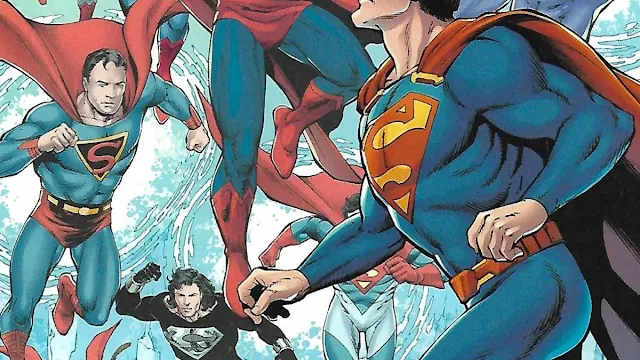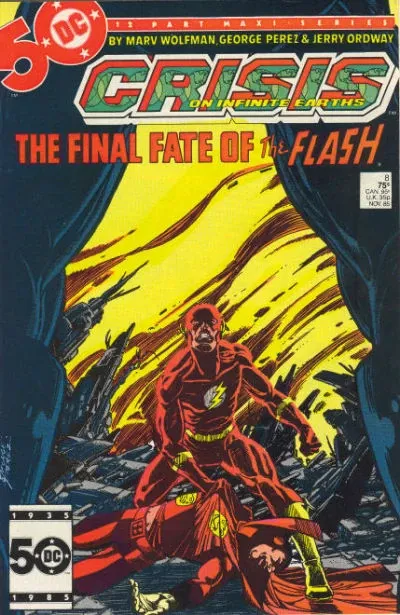At its core, "Crisis on Infinite Earths" is a story about the end of the multiverse. The Anti-Monitor, a cosmic being of immense power, seeks to destroy all life in the multiverse and remake it in his own image. The story follows the efforts of various DC superheroes and supervillains from different parallel universes as they band together to stop the Anti-Monitor and save the multiverse from certain doom.
The plot of "Crisis on Infinite Earths" is a masterclass in storytelling, as Marv Wolfman weaves together various characters and storylines from across the DC Universe into a coherent and compelling narrative. The action is non-stop, with epic battles and emotional moments aplenty. The stakes are high, and the sense of danger is palpable throughout the series. George Pérez's art is breathtaking, with his attention to detail and sense of scale bringing the story to life in a way that few other artists could.

The themes of Infinite Crisis
"Crisis on Infinite Earths" is a story that touches on several themes that are universal and timeless. From heroism and sacrifice to teamwork and loss, the series explores these themes in ways that are both relatable and inspiring. Let's take a closer look at some of the key themes in "Crisis on Infinite Earths."
Sacrifice
Throughout "Crisis on Infinite Earths," characters
are forced to make difficult choices and sacrifices in order to save the
multiverse from destruction. One of the most notable examples of this is when
Barry Allen, aka the Flash, sacrifices himself to stop the Anti-Monitor's
anti-matter cannon. The scene is a poignant one, as Barry's selflessness and
bravery are on full display. His sacrifice serves as a reminder that sometimes,
heroes must be willing to give everything they have in order to protect the people
and worlds they care about.
Heroism
"Crisis on Infinite Earths" is full of heroic
moments, from Superman's valiant efforts to hold up the Anti-Monitor's tower to
the numerous battles fought by the heroes of various Earths. The series
celebrates heroism in all its forms, whether it's through physical strength,
intelligence, or sheer force of will. The heroes in "Crisis on Infinite
Earths" are not perfect, but they are willing to do whatever it takes to
save the multiverse and protect the innocent. Their heroism is inspiring and
serves as a reminder that even in the darkest of times, there are those who
will stand up and fight for what's right.
Teamwork
One of the key themes in "Crisis on Infinite
Earths" is the power of teamwork. The heroes of the DC Universe must come
together in order to stop the Anti-Monitor and save the multiverse. They must
put aside their differences and work together, pooling their resources and
talents to achieve a common goal. The series shows that when people work
together, they can accomplish incredible things, even in the face of seemingly
insurmountable odds.
Loss
This is not just a story
about victory and heroism; it's also a story about loss. Throughout the series,
characters die, worlds are destroyed, and the heroes of the DC Universe are forced
to confront the harsh realities of their situation. These losses are not just
physical, either; the heroes must also deal with the emotional toll of fighting
for what's right. The series is a reminder that even in victory, there are
often costs that must be paid.
The varied versions of Superman and co
1. Golden Age Superman
2. Earth-2 Superman
3. Earth-1 Superman
4. Superman of Earth-3
The family relationships between the different versions of Superman are complex and interconnected. The Golden Age Superman and Earth-2 Superman are both married to Lois Lane, although they have different children. The Earth-1 Superman, on the other hand, is not married and has no children. The Superman of Earth-3 is married to Lois Lane, but their relationship is twisted, as they are both villains.
The origins and intent of the Anti-Monitor
The origins of the Anti-Monitor are rooted in the creation of the DC Multiverse, which was introduced in the 1960s as a way to explain the existence of different versions of DC Comics characters. Over time, the Multiverse became increasingly complex, with an infinite number of parallel Earths and alternate versions of characters.
In "Crisis on Infinite Earths," the Anti-Monitor seeks to destroy the Multiverse and create a single, unified universe under his control. He is portrayed as an incredibly powerful being with the ability to manipulate energy and matter on a cosmic scale. His ultimate goal is to eliminate all life in the multiverse and become the sole ruler of the resulting "anti-matter" universe.
The Anti-Monitor's origins are also explored in the series. He is revealed to be the counterpart of the Monitor, a being tasked with maintaining the balance of the multiverse. The Monitor and the Anti-Monitor were created by a race of beings known as the Oa, who also created the Green Lantern Corps.
The intent of the Anti-Monitor is to bring order to the chaos of the multiverse. He believes that a single universe is necessary for true stability, and he is willing to destroy countless worlds and lives to achieve his goal. In many ways, the Anti-Monitor represents the opposite of the heroes who fight against him. He is ruthless, calculating, and willing to make any sacrifice to achieve his aims, while the heroes are selfless, brave, and determined to protect life and freedom.
The Death of Supergirl
In issue #7 of the series, Supergirl sacrifices herself to save the multiverse from the Anti-Monitor, a powerful villain who sought to destroy all of existence. Despite the efforts of various heroes, Supergirl was ultimately unable to defeat the Anti-Monitor and died in battle.
The death of Supergirl was a shock to readers at the time, as she was one of DC's most popular characters. However, it served as a powerful reminder of the risks and sacrifices that heroes must make to protect the greater good. It also paved the way for new characters and storylines to emerge in the newly reorganized DC universe.
The impact of Supergirl's death was felt throughout the DC universe, and the character has been resurrected and reinvented several times since. However, her sacrifice in Crisis on Infinite Earths remains a memorable and significant moment in comic book history.
The Death of Barry Allen
Barry's death was a shocking and emotional moment for readers, as he was one of DC's most beloved characters. However, his sacrifice was essential to the plot of Crisis on Infinite Earths, as it ultimately helped to defeat the Anti-Monitor and save the multiverse.
The impact of Barry's death was felt throughout the DC universe, and the character remained dead for over two decades until his eventual resurrection in 2009. The legacy of Barry Allen as the Flash, and his willingness to make the ultimate sacrifice, has been a recurring theme in DC Comics and has been explored in various storylines.
How Crisis on Infinite Earths reset the DC universe
"Crisis on Infinite Earths" was a massive event in the DC Universe that aimed to simplify and streamline the continuity of DC Comics. The storyline involved the destruction of the Multiverse and the merging of the surviving Earths into a single universe, with the purpose of simplifying the complex and sometimes contradictory history of DC's characters. The event led to significant changes in the DC Universe, such as the deaths of several major characters, and set the stage for future storylines.
The most significant way in which "Crisis on Infinite Earths" set up the reset of the DC Universe was by providing a foundation for a single, cohesive continuity. Before the event, DC's comics were set in different parallel universes, with multiple versions of the same characters existing simultaneously. This led to confusion and continuity errors that made it difficult for new readers to enter the world of DC Comics. The series merged these parallel universes, allowing the creation of a more streamlined and consistent continuity.
In addition, "Crisis on Infinite Earths" served as a catalyst for many other significant changes in the DC Universe. The event led to the introduction of new characters, such as the character of Pariah, who played a key role in the storyline. It also saw the death of several major characters, such as Barry Allen, the second Flash, and Supergirl. These deaths had long-lasting effects on the DC Universe, and the event paved the way for new characters to take their place.
"Crisis on Infinite Earths" created a new starting point for many DC characters, with their histories and backstories rewritten or updated to fit into the new continuity. This allowed DC to reintroduce characters and storylines that had previously been discarded or overlooked, and to streamline their histories in a way that was more accessible to new readers.
The critical and commercial success of Crisis on Infinite Earths
Commercially, the series was a massive success, with the first issue alone selling over 250,000 copies, which was a record-breaking number at the time. The series went on to sell over eight million copies worldwide, and its impact on the comic book industry was significant. It led to an increase in sales for DC Comics and helped to establish the company as a major player in the industry.
The series had long-lasting effects on the DC Universe, with the event setting the stage for significant changes in the continuity of DC's characters. It led to the creation of a more streamlined and consistent continuity, and paved the way for the introduction of new characters and storylines. The event also helped to raise awareness of DC Comics and its characters, leading to a surge in popularity for many of the company's properties.
Here are 11 pieces of trivia about the production of Crisis on Infinite Earths:
- The series was originally intended to be six issues long, but was later expanded to 12 due to the ambitious scope of the story.
- The first issue of Crisis on Infinite Earths was released in April 1985.
- The series featured appearances by virtually every major DC Comics character, including Superman, Batman, Wonder Woman, and the Flash.
- Crisis on Infinite Earths marked the first appearance of the villainous Anti-Monitor, who would go on to become a major antagonist in the DC Universe.
- The series was also notable for its use of double-page spreads, which allowed for more detailed and expansive storytelling.
- Crisis on Infinite Earths was published as part of DC Comics' 50th anniversary celebrations.
- Crisis on Infinite Earths was followed by several spin-off series, including "Legends" and "Millennium".
- The series has been collected in several different formats, including a deluxe hardcover edition released in 2015.
- Crisis on Infinite Earths has been referenced in various other DC Comics stories, including "Infinite Crisis" and "Final Crisis".
- Crisis on Infinite Earths was one of the first major crossover events in comic book history, paving the way for future events like "Secret Wars" and "Civil War" in the Marvel Universe.
- The cover of Crisis on Infinite Earths #7, featuring the deaths of Supergirl and the Flash, is one of the most iconic and memorable comic book covers of all time.


















